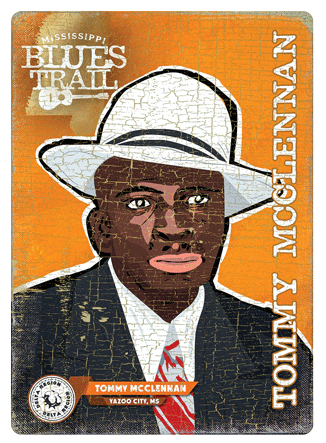
One of the earliest blues musicians from Mississippi to make recordings, Ishmon Bracey (1899-1970) is buried in the nearby Willow Park Cemetery. In the 1920s and ‘30s Bracey was a leading bluesman in the Jackson area and performed with prominent artists including Tommy Johnson, Rube Lacy, and Charlie McCoy. In the early ‘50s Bracey became an ordained minister and left the blues behind.
Bracey was born in Byram, about ten miles south of Jackson, in January 1899, according to census records. He learned guitar from locals Louis Cooper and Lee Jones and moved to Jackson in the late 1920s after encountering Tommy Johnson, one of Mississippi’s most prominent bluesmen, in Johnson’s longtime home of Crystal Springs. Bracey soon became one of the most popular musicians in the Jackson area’s vital blues scene, which consisted largely of musicians who were likewise born in small communities in the area. These included Johnson, his brothers LeDell, Clarence, and Mager, and R. D. “Peg Leg Sam” Norwood of Crystal Springs; Rubin Lacy, Shirley Griffith, John Henry “Bubba” Brown, “Son” Spand , and brothers Luther and Percy Huff, all of Rankin County; brothers Joe and Charlie McCoy of Raymond; Johnnie Temple of Canton; Lucien “Slim” Duckett of Tylertown; and, from Bolton, Walter Vinson, Caldwell “Mississippi” Bracy, and the Chatmon family (brothers Bo, Harry, Lonnie, and several others).
Jackson blues in the 1920s had a lighter feel than its counterpart in the Delta and sometimes featured the mandolin and the fiddle. Bracey and other musicians often played at dances for both black and white audiences, performing waltzes and ragtime numbers, and otherwise serenaded passersby on the busy streets of Jackson. Bracey’s music came to broader attention after he auditioned for recording agent H. C. Speir, who operated a furniture store on North Farish Street. Speir arranged for Bracey and Tommy Johnson to make their debut recordings at a session for Victor in Memphis in February of 1928. At that session and another for Victor later that year, Bracey was accompanied on guitar and mandolin by Charlie McCoy. Bracey recorded in more of a jazz mode in late 1929 and early 1930 for the Paramount label in Grafton, Wisconsin, backed by the New Orleans Nehi Boys (Charlie Taylor on piano and “Kid” Ernest Moliere on clarinet, an instrument rarely heard on Mississippi blues recordings). Bracey’s musical breadth is suggested in the 1930 census, where his occupation is listed as a musician in a “hotel orchestra.”
By the mid-‘30s many of the musicians in Bracey’s circle had left the area, and his musical partnership with Tommy Johnson ended. In later city directories he is listed as a laborer or painter. In 1963, when blues researcher Gayle Dean Wardlow met and interviewed him in Jackson, Bracey had been a Baptist minister for over a decade, and, although he would no longer play blues, he provided important information on the early blues scene in Jackson. He died on Feb. 12, 1970.


